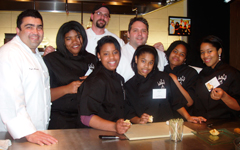5 Grocery Shopping Hacks I've Learned at Brainfood
As a youth worker, my job is not primarily about food or cooking. However, grocery shopping perpetually occupies a line on my to-do list. As is the case for many of us at home, groceries do not magically appear in our Brainfood refrigerators and pantries prior to class.
Grocery shopping is one of the unassuming tasks that keeps Brainfood programs running, and, while it’s a necessary undertaking, we have many other things to keep us busy. That is why we Brainfood teachers are motivated to be proficient grocery shoppers.
In a blog post last month, a fellow Brainfood staffer wrote about kitchen tips and tricks she’s picked up while teaching at Brainfood. Here, I am going to share 5 pointers I’ve learned at Brainfood for an efficient grocery shop. If you are like us, shopping on a budget and limited time, these tips might be helpful for you too!
1. Shop the store backwards – The validity of this tip may depend on how your particular grocery store is set up. However, most supermarkets are designed so that shoppers are greeted near the entrance with fresh produce. I know, I know—the colorful sensory experience is tempting. However, if you opt to shield your eyes from temptation and walk to the opposite end of the store to begin, you can accomplish two things.
First, you’ll end your shop in the produce section; this means your vulnerable fruits and vegetables will rest gently on top of your mountain of groceries instead of squished at the bottom. Second, I have noticed that shopping the store backwards means you are less likely to encounter as much traffic from other shoppers.
2. Stick to a list, and write your list in order of the aisles – Spend time planning in advance instead of improvising in the store. You’ll be less tempted to buy that unnecessary “extra something,” and you’ll save time by eliminating the in-store decision making process. When you know what you need, you can utilize your knowledge of your supermarket’s layout to organize your list by the aisles in the store (starting with the last aisle if you’re following tip #1!).
3. Make friends with store employees – Brainfood staffers may have an advantage here, as we are often in the store 2-3 times per week—enough to be a familiar face. Having a friend who stocks the shelves or works at the meat counter not only makes shopping more fun, but also means you have a helping hand when you can’t find an elusive item or if you want to know when the next shipment is coming in.
4. Compare products by unit price – Price labels often, though not always, list both a product’s retail price and its unit price. Unit pricing takes the price of an item and divides it by a standard unit of measurement (such as ounces or quarts) to provide a simple price comparison point. Use the unit price when comparing brands or different sizes of packaging to get the best deal.
5. Check out in the shortest line – This may be taking efficiency to an entirely different level, but, mathematically, there is a best way to hit the checkout stand. If you’re like me, your tendency is pick a checkout lane in which people are waiting with the fewest items. This is a place to start, but not necessarily the optimal strategy.
Mathematician and educator Dan Meyer says it’s best to pick the line with the least amount of people in it, regardless of how many items they’re holding. Data indicates that when you add one person to the line, nearly a minute is tacked on to checkout length. Meanwhile, an extra item costs less than 3 seconds. Therefore, you would rather add 17 more items to the line than one extra person. Compelling, right?
So there you have it, folks. I hope my analysis helps you speed through your next grocery shop. Save your precious time for deciding the movie you’ll be watching after dinner.







Comments
Post new comment